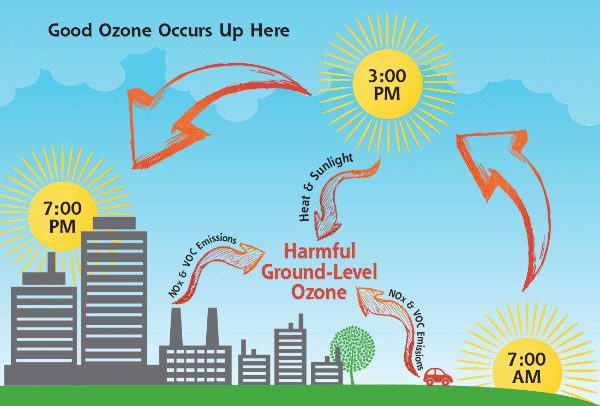Ozone is tricky.
The layer of this odorless, colorless gas in the sky serves as a sunscreen of sorts, filtering out harmful ultraviolet sunlight. When ozone is located in Earth’s upper atmosphere, it’s a good thing.
The ozone layer in the atmosphere, which was found to be thinning in the 1970s, is healing – and according to the EPA, should be at a healthy level by 2065.
The bad news is ozone on the ground continues to be a health hazard. Unfortunately, readings in the Omaha-Council Bluffs metro area continue to be on the brink of EPA’s unacceptable, or “non-attainment,” level, especially on hot days.

“We’ve found that the general public does not perceive this to be a problem, but it’s actually a big deal,” said the City of Omaha’s Air Quality Control Technician Dan May.
If our area goes over the limit for acceptable levels of ozone, several things could happen:
- Stricter pollution controls, which can create serious economic development consequences
- Increased paperwork and reporting for businesses
- More state oversight and control by the EPA
- Possible limits to transportation improvements that get funded
Just like we are healing the ozone layer in our upper atmosphere, we can help diminish levels down here on the ground. Little Steps Cleaner Air is an outreach campaign run by the Metropolitan Area Planning Agency, and is funded by grants from the Federal Highway Administration and the Nebraska Environmental Trust. The campaign encourages residents in the greater Omaha metro to take small steps to improve the air quality in our area.
“More than half of the emissions that cause ground-level ozone come from daily activities and products we use. If all of us make little changes, we can have a big impact on the air we breathe,” said MAPA Information Officer Sue Cutsforth.
Some of these steps include:
-
Drive less.
Carpool, take the bus, and walk or bike whenever possible. Run all your errands in one trip to be more efficient with your fuel usage.
-
Turn off your car when idling for more than 30 seconds.
Idling your car for more than 30 seconds uses more fuel than stopping and starting your engine.
-
Make sure your tires are inflated properly and that your engines are maintained.
Cars, trucks and even boats burn fuel more efficiently when they’re in proper working order.
-
Buy an electric or manual lawn mower, or mow your yard during the cooler hours of the day.
Even small engines in gas-powered mowers, leaf blowers and trimmers release as much as 25 percent of unburned gasoline into the air.
-
Convert your wood-burning fireplace into gas.
Wood smoke has harmful health and environmental effects, and is less energy efficient than gas.
-
Weatherize your home by sealing cracks and insulating your walls and attic.
You will use less energy because your heater and air conditioner won’t have to work as hard.
-
Buy environmentally safe cleaning products and paint.
Recent studies have shown the environmental impact of the volatile organic compounds (VOCs) that come from solvents, paint, chemicals and cleaning products have been underestimated in the past, so use as little as possible.
